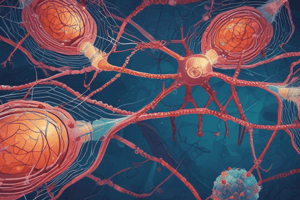Podcast
Questions and Answers
What is the role of the molecular ratchet in protein import?
What is the role of the molecular ratchet in protein import?
- It provides the driving force for protein import after initial insertion. (correct)
- It binds to the SRP and SRP receptor to bring the ribosome to the membrane.
- It is responsible for the formation of the Sec62 and Sec63 proteins.
- It helps to initially insert the precursor into the Sec61 translocator.
What is the role of the SRP and SRP receptor?
What is the role of the SRP and SRP receptor?
- To drive the translocation of proteins across the membrane using ATP.
- To engage with the Sec61 translocator and thread the polypeptide chain across the membrane.
- To position BiP molecules where they can bind to the translocating chain.
- To bring the ribosome to the membrane. (correct)
During co-translational translocation, what is the role of the growing polypeptide chain?
During co-translational translocation, what is the role of the growing polypeptide chain?
- It is threaded across the membrane as it is made. (correct)
- It pulls itself across the membrane.
- It is initially inserted into the translocator by the Sec62 and Sec63 proteins.
- It is fed from the cytosolic side into the Sec61 translocator.
What is the role of the Sec62 and Sec63 proteins in post-translational translocation?
What is the role of the Sec62 and Sec63 proteins in post-translational translocation?
What is the role of BiP molecules in post-translational translocation?
What is the role of BiP molecules in post-translational translocation?
What is the role of the SecA ATPase in post-translational translocation in bacteria?
What is the role of the SecA ATPase in post-translational translocation in bacteria?
Where is the Sec62–Sec63 complex found?
Where is the Sec62–Sec63 complex found?
Where is the SecA ATPase found?
Where is the SecA ATPase found?
During co-translational translocation, what is the energy source?
During co-translational translocation, what is the energy source?
What is the function of the SecY translocator in bacteria?
What is the function of the SecY translocator in bacteria?
Flashcards are hidden until you start studying
Study Notes
Trafficking Ways of Proteins
- There are four fundamentally different ways a protein is moved from one compartment to another.
Protein Translocation
- Transmembrane protein translocators directly transport specific proteins from the cytosol into a topologically distinct space.
- The transported protein molecule usually must unfold to snake through the translocator.
- The initial transport of selected proteins from the cytosol into the ER lumen, the ER membrane, or mitochondria occurs in this way.
Gated Transport
- Proteins and RNA molecules move between the cytosol and the nucleus through nuclear pore complexes in the nuclear envelope.
- The nuclear pore complexes function as selective gates that support the active transport of specific macromolecules and macromolecular assemblies between the two topologically equivalent spaces.
Vesicular Transport
- Membrane-enclosed transport intermediates ferry proteins from one topologically equivalent compartment to another.
- The transport intermediate becomes loaded with a cargo of molecules derived from the lumen and membrane of the originating compartment as it buds and pinches off.
- At the destination compartment, the transport intermediate fuses with the compartment's enclosing membrane to discharge its cargo.
Engulfment
- Double membrane sheets wrap around portions of the cytoplasm, often including fragments of organelles or even entire organelles.
- This membrane structure then seals by membrane fusion to enclose a separate compartment, the autophagosome.
Sorting Signals and Sorting Receptors
- Sorting signals are usually composed of amino acid side chains in a protein and come in two general varieties: signal sequence and batch sequence.
- Signal patch: a specific three-dimensional arrangement of amino acids.
- Signal sequence: a linear sequence of about 5–10 predominantly hydrophobic amino acids.
- The linear signal sequences for protein translocation are often found at the N-terminus of the polypeptide chain.
- These N-terminal signal sequences are usually removed from the finished protein by specialized signal peptidases once the sorting process is complete.
Examples of Signal Sequences
- Proteins destined for mitochondria have signal sequences that include positively charged amino acids.
- The signal for protein import into the nucleus is composed primarily of positively charged amino acids.
- Proteins for peroxisomes have a signal sequence of three characteristic amino acids at their C-terminus.
The Endoplasmic Reticulum (ER)
- The membrane of the ER typically constitutes more than half of the total membrane of an average animal cell.
- The ER is organized into a netlike labyrinth of branching tubules and flattened sacs that extend throughout the cytosol.
- The tubules and sacs interconnect, and their membrane is continuous with the outer nuclear membrane.
- ER in most eukaryotic cells is to sequester Ca2+ from the cytosol.
Experimental Basis for the Signal Sequences
- Signal sequences were discovered in secreted water-soluble proteins that are first translocated across the ER membrane.
- The signal hypothesis was formulated to explain these observations.
Signal-Recognition Particle (SRP)
- The ER signal sequence is guided to the ER membrane by at least two components: a signal-recognition particle (SRP), which binds to the signal sequence, and an SRP receptor in the ER membrane.
Post-Translocation
- Post-translational translocation: proteins are completely synthesized in the cytosol as precursors before they are imported into the ER.
- Post-translational protein translocation is more common across the yeast ER membrane and the evolutionarily related bacterial plasma membrane.
Co-translational Translocation
- The signal peptide of a precursor directly engages the Sec61 translocator to open the channel.
- To pull proteins into the ER lumen, eukaryotic cells use accessory proteins called Sec62 and Sec63 that associate with the Sec61 translocator and position an hsp70-like chaperone protein (called BiP) adjacent to the lumenal opening of the translocation channel.
Studying That Suits You
Use AI to generate personalized quizzes and flashcards to suit your learning preferences.




